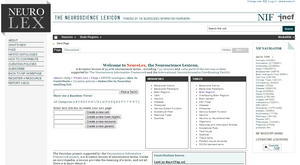
NeuroLex
 | |
| Content | |
|---|---|
| Description | Dynamic lexicon of neuroscience terms in a Semantic wiki |
| Data types captured |
Neuroscience |
| Contact | |
| Authors | Maryann Martone, Stephen Larson and others |
| Access | |
| Website | https://scicrunch.org/scicrunch/interlex/dashboard |
| Miscellaneous | |
| License |
Creative Commons Attribution 3.0 Unported License |
NeuroLex is a lexicon of neuroscience concepts supported by the Neuroscience Information Framework project. It is structured as a semantic wiki, using Semantic MediaWiki.
Overview
The NeuroLex is intended to help improve the way that neuroscientists communicate about their work by using common and consistent terminologies to enable easy data integration and interpretation across different studies and resources.
Utilization within the Neuroscience Information Framework
The Neuroscience Information Framework (NIF) enables discovery and access to public research data and tools worldwide through an open-source, networked environment. Funded by the NIH Blueprint for Neuroscience Research [1], the NIF allows scientists and students to discover global neuroscience web resources that cut across traditional boundaries, from experimental, clinical, and translational neuroscience databases to knowledge bases, atlases, and genetic and genomic resources.
NIF provides deeper access to a more focused set of resources that are relevant to neuroscience, search strategies tailored to the field, and access to content that is traditionally "hidden" from web search engines. The Framework is an inventory of neuroscience databases, annotated and integrated with a unified system of biomedical terminology (i.e., NeuroLex). NIF supports concept-based queries across multiple scales of biological structure and multiple levels of biological function, making it easier to search for and understand the results.
As part of the NIF, a search interface to many different sources of neuroscience information and data is provided. To make this search more effective, the NIF is constructing ontologies to help organize neuroscience concepts into category hierarchies, e.g., stating that a neuron is a cell. This allows users to perform more effective searches and to organize and understand the information that is returned. But an important adjunct to this activity is to clearly define all of the terms that are used to describe data.
Content
The initial entries in NeuroLex were built from the NIFSTD ontologies, which subsumed an earlier vocabulary, BIRNLex. It currently contains concepts that span gross anatomy, cells of the nervous system, subcellular structures, diseases, functions, and techniques. NIF is soliciting community input to add more content and correct what is there.
See also
Further reading
NIF was featured in a special issue of Neuroinformatics, published in September 2008:
- Bug WJ, Ascoli GA, Grethe JS, Gupta A, Fennema-Notestine C, Laird AR, Larson SD, Rubin D, Shepherd GM, Turner JA, Martone ME (September 2008). "The NIFSTD and BIRNLex vocabularies: building comprehensive ontologies for neuroscience". Neuroinformatics. 6 (3): 175–94. doi:10.1007/s12021-008-9032-z. PMC 2743139. PMID 18975148. Archived from the original on February 12, 2009.
- Gardner D, Akil H, Ascoli GA, Bowden DM, Bug W, Donohue DE, Goldberg DH, Grafstein B, Grethe JS, Gupta A, Halavi M, Kennedy DN, Marenco L, Martone ME, Miller PL, Müller HM, Robert A, Shepherd GM, Sternberg PW, Van Essen DC, Williams RW (September 2008). "The neuroscience information framework: a data and knowledge environment for neuroscience". Neuroinformatics. 6 (3): 149–60. doi:10.1007/s12021-008-9024-z. PMC 2661130. PMID 18946742.
- Gardner D, Goldberg DH, Grafstein B, Robert A, Gardner EP (September 2008). "Terminology for neuroscience data discovery: multi-tree syntax and investigator-derived semantics". Neuroinformatics. 6 (3): 161–74. doi:10.1007/s12021-008-9029-7. PMC 2663521. PMID 18958630.
- Gupta A, Bug W, Marenco L, Qian X, Condit C, Rangarajan A, Müller HM, Miller PL, Sanders B, Grethe JS, Astakhov V, Shepherd G, Sternberg PW, Martone ME (September 2008). "Federated access to heterogeneous information resources in the Neuroscience Information Framework (NIF)". Neuroinformatics. 6 (3): 205–17. doi:10.1007/s12021-008-9033-y. PMC 2689790. PMID 18958629.
- Halavi M, Polavaram S, Donohue DE, Hamilton G, Hoyt J, Smith KP, Ascoli GA (September 2008). "NeuroMorpho.Org implementation of digital neuroscience: dense coverage and integration with the NIF". Neuroinformatics. 6 (3): 241–52. doi:10.1007/s12021-008-9030-1. PMC 2655120. PMID 18949582.
- Marenco L, Ascoli GA, Martone ME, Shepherd GM, Miller PL (September 2008). "The NIF LinkOut broker: a web resource to facilitate federated data integration using NCBI identifiers". Neuroinformatics. 6 (3): 219–27. doi:10.1007/s12021-008-9025-y. PMC 2704600. PMID 18975149.
- Marenco L, Li Y, Martone ME, Sternberg PW, Shepherd GM, Miller PL (September 2008). "Issues in the design of a pilot concept-based query interface for the neuroinformatics information framework". Neuroinformatics. 6 (3): 229–39. doi:10.1007/s12021-008-9035-9. PMC 2664632. PMID 18953674.
- Müller HM, Rangarajan A, Teal TK, Sternberg PW (September 2008). "Textpresso for neuroscience: searching the full text of thousands of neuroscience research papers". Neuroinformatics. 6 (3): 195–204. doi:10.1007/s12021-008-9031-0. PMC 2666735. PMID 18949581.
External links
-
 Interlex ID (P696) (see uses)
Interlex ID (P696) (see uses)